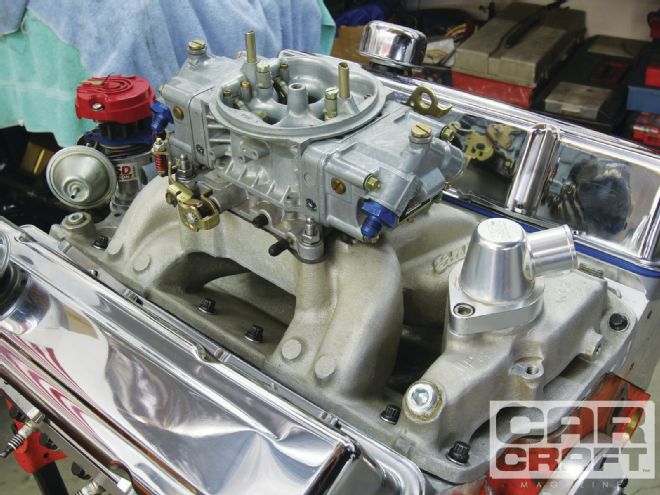
If you're a typical car crafter, one of the first performance-engine parts you bought was probably a dual plane intake manifold. A well-designed dual plane intake can improve torque, add horsepower, and make that otherwise stock engine look a little more aggressive. But it wasn't until we started counting did we realize the incredible variety of choices when it comes to choosing a dual plane intake manifold for a small block Chevy. We collected a 23-deep pile of dual plane intakes to continue with our small block Chevy dual plane intake comparison. The collection of manifolds could have been even larger, but we limited our test to the'55–'86-style bolt pattern. We bypassed both the Vortec intake and the '87 to mid-'90s intakes, on which the four center-bolt angles were altered. We mentioned that this intake comparison is part of a series of small block Chevy components testing we've completed. The first was a budget cylinder head-test in the Sept. '12 issue ("Eight-Budget-SBC-Head Shootout"), in which we wrestled eight less-than-$1,000 heads on our Slayer 350 small block Chevy. The following month, we looked at a bunch of inexpensive four-barrel carburetors ("The Great $299 Carburetor Shootout," Oct. '12). Most recently, in our June '13 issue, we completed our massive single-plane comparison ("The Great Intake Flog"), testing 19 intakes on our 406ci small block that is this month's test mule. A little teaser: If you were to combine the "winners" of these previous tests, you would have a fairly powerful combination—and that's exactly what you can expect us to do in an upcoming issue. That's our not-so-subtle way to keep you reading Car Craft.
Dual Plane Intake Test Engine
As we did with our single plane intake comparison, we are using the 406ci small block Chevy first introduced in the May '11 issue ("Build a 400ci Torque Monster For $2,500") and later rebuilt as "Build Big-Hammer Power" in the Dec. '11 issue. We've decided to call this engine Rodney Dangerfield because it gets no respect— only abuse. By the time we were done with this test, the 406 had slogged through more than 150 dyno runs with nary a whimper. The engine is basically the same as the one used in the June '13 single plane intake test, with a change to a milder Crane camshaft that is more in line with what would be used in a dual plane intake application. We've retained the same Crane Gold 1.6:1 roller rockers and 0.080-inch-wall pushrods. We also retained the TFS 215cc heads used in the previous test to ensure we could flow enough air to evaluate the intake manifolds and not the cylinder heads. Because we didn't expect to exceed 500 hp, we chose a more compatible 750-cfm Holley HP mechanical-secondary carburetor that worked well out of the box, needing only minor jet and air-bleed changes from time to time to ensure the air/fuel (A/F) ratio curve remained between 12.5 and 13.1:1. Finally, Westech's 13⁄4-inch dyno headers and 3-inch Flowmaster mufflers directed the exhaust.
Dual Plane Intake Test Procedure
With this many intake manifolds, we expected the competition would be very close. This demanded a very accurate test procedure to achieve best results. This meant that Westech dyno guru Steve Brulé had to control several variables, the most important of which was A/F ratio. Because we were using a carburetor, the A/F ratio is subject to significant swings based on manifold design. Carburetors also don't produce the same A/F ratio throughout the entire power curve. We made sure each test maintained an A/F ratio range within 12.5:1 and 13.1:1. That was the best we could do without custom-tuning the carburetor for each manifold. We also made sure the oil temperature was consistent for each test because cold oil can cost upwards of 5–10-lb-ft of torque and similar horsepower numbers. These requirements eventually dictated a test procedure in which we would subject each manifold to anywhere from three to five test runs until we had two curves within 0.5 percent. Then we averaged those two runs into a single curve. This eliminates an individual "hero" run from tweaking our results. In order to maintain timing accuracy, we used an MSD crank trigger with total timing set to 34 degrees, removing the variable of resetting the timing each time we changed manifolds. We also re-ran the first intake manifold tested at the end of the test to ensure that our 406 was still producing the same power. When the re-test gave us nearly identical results from the first run three days earlier, we knew our tests were as accurate as we could produce.
Overall, the dual plane intake test required the better part of three days, but we think accurate results were well worth the effort. Also, the TFS aluminum 215cc heads now have had nearly 50 intakes bolted to them, and those intake threads in the heads have held up just fine. Hero status is awarded to whomever does the heat-treating on those TFS heads! A big thank you to Fel-Pro for all the intake gaskets we blew through in this test and to Permatex for the big tubes of The Right Stuff RTV we used to keep the oil inside the engine. We've also used the Ultra Grey and Ultra Black with great results. Finally, thanks to Summit Racing for supplying a large pile of 3⁄8- and 1⁄2-inch Allen pipe plugs to seal up many of these manifolds. The Holley intakes came with plugs, though most of the other intakes do not.
Short Manifolds (Less Than 5.00 Inch Carb Pad Height)
Manifold PN Price Peak TQ Peak HP Avg. TQ Carb Ht. TQ at 3,000 Edelbrock EPS 2701 $139.95 506 461 466.2 4.80 476 Edelbrock Air Gap 2601 $225.95 504 458 464.7 4.92 478 Chevrolet ZZ4 10185063 $239.95 500 471 464.5 4.95 467 Weiand Street Warrior 8125 $151.95 501 463 463.5 3.65 470 Weiand Street Warrior 8120 $134.95 502 459 462.8 4.62 471 Summit Stage 1 226012 $131.95 498 459 461.0 4.65 468 Edelbrock Performer 2101 $157.95 494 456 459.1 4.60 470 Prof. Prod. Cyclone 52001 $143.95 487 436 449.3 4.72 471
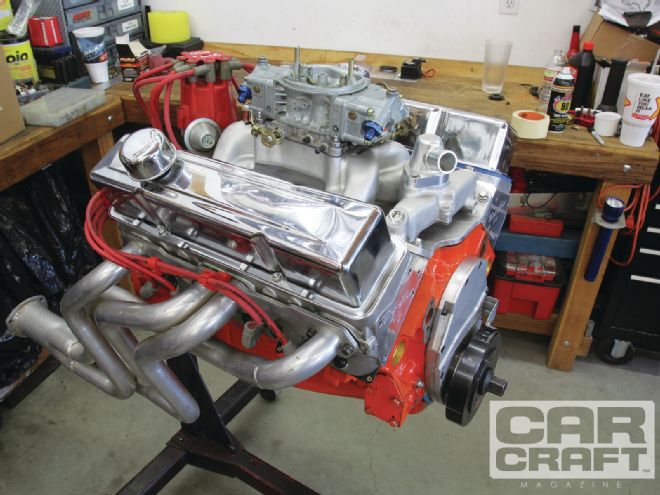 Our test engine is the same 406ci small-block we used for the single-plane intake manifold test, with a change to more conservative cam timing that is closer to what would be typical for a dual-plane intake manifold–equipped engine. We also used a smaller 750hp Holley carburetor instead of the 850 Ultra HP employed in the single-plane test.
Our test engine is the same 406ci small-block we used for the single-plane intake manifold test, with a change to more conservative cam timing that is closer to what would be typical for a dual-plane intake manifold–equipped engine. We also used a smaller 750hp Holley carburetor instead of the 850 Ultra HP employed in the single-plane test.
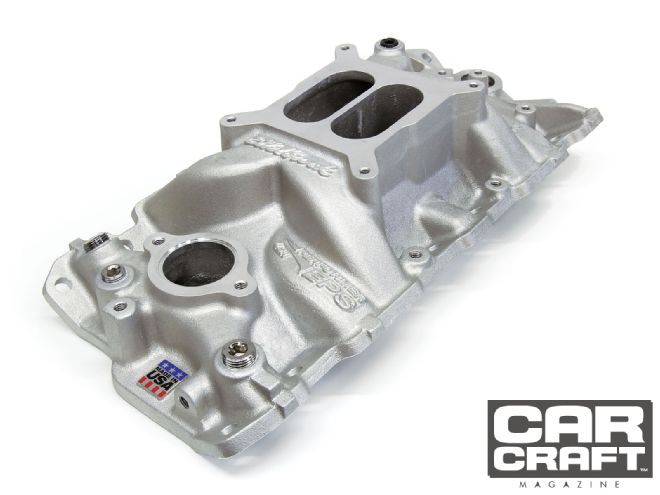 Edelbrock says the EPS is worth 9 lb-ft over the 2101 on a 350ci engine. We saw 12 lb-ft with our 406 over the 2101, and the EPS bettered the 2601 Performer Air Gap in average torque. Even better, the EPS saves $20 over the 2101. Within the short manifolds, the EPS is an excellent choice.
Edelbrock says the EPS is worth 9 lb-ft over the 2101 on a 350ci engine. We saw 12 lb-ft with our 406 over the 2101, and the EPS bettered the 2601 Performer Air Gap in average torque. Even better, the EPS saves $20 over the 2101. Within the short manifolds, the EPS is an excellent choice.
Medium Manifolds (5.00 to 5.30 Inches Carb Pad Height)
Manifold PN Price Peak TQ Peak HP Avg. TQ Carb Ht. TQ at 3,000 AFR Titon 4804 $579.00 510 484 473.6 5.29 467 Edelbrock Air Gap 7501 $234.95 508 474 471.2 5.26 473 Edelbrock RPM 7101 $174.95 504 470 468.3 5.25 474 Weiand Warrior 8501 $217.95 504 466 466.3 5.24 471 Summit Stage 3 226010 $182.95 503 464 465.6 5.25 471 Edelbrock RPM Q-Jet 7104 $199.95 501 465 465.3 5.25 471 Summit Stage 2 226014 $132.95 502 469 464.9 5.18 466 Weiand Speed War 8150 $145.95 502 467 464.9 5.18 467 Jegs 513000 $ 99.99 500 471 464.5 5.29 462 Professional Products Crosswind 52026 $199.95 496 457 459.5 5.24 469
Tall Manifolds (5.30 Inches and Taller)
Manifold PN Price Peak TQ Peak HP Avg. TQ Carb Ht. TQ at 3,000 Professional Products Typhoon 52021 $162.95 499 469 465.3 5.33 471 TFS StreetBurner 30400222 $224.95 501 465 465.2 5.39 473 Dart SHP 42811000 $231.70 501 464 463.7 5.52 470 Professional Products Cyclone-Plus 52013 $177.95 497 458 461.0 5.37 471 Chevy Iron 14096011 $261.06 494 457 459.0 5.45 468
Peak Torque and Horsepower
We have to acknowledge how amazingly tight this field is in terms of peak torque. How close? It is fair to say that it would be difficult to feel the difference of 2 percent of power. That's 10 lb-ft of torque, the difference between the Third Place Edelbrock EPS manifold at 506 lb-ft and the Professional Products Crosswind (52026), which placed 20th. Also note that in the peak-torque category, three of the top five manifolds are Edelbrock castings. When it comes to dual-plane intakes, torque is king, and it appears the Edelbrock has this part of the power curve dialed in.
Torque at 3,000 rpm is another important category that we listed in the initial description chart for each manifold. We opted to include this bit of data because it relates to low-speed power. With a performance torque converter, this would be just after the converter hits. Note that the relatively short Edelbrock 2601 Performer Air Gap manifold makes more torque at 3,000 than any other manifold. Compare its 478 lb-ft to the Jegs manifold's 462 lb-ft, to see that the Air Gap makes 16 lb-ft more torque. We guarantee you will feel 16 lb-ft in the seat of your pants. We think this can be partially attributed to the plenum-wall cutout on the Jegs manifold, but the TFS and Dart manifolds also have this feature, and those manifolds are only down by a single-digit compared with the Edelbrock. For a mild street engine (especially with stock or near-stock heads), this low-speed torque value should be given greater consideration.
Now let's talk peak horsepower. While the field gets a little more spread out in this category, the difference between the Third-Place Jegs Champion and the 21st place Edelbrock Performer is only 15 hp—barely a 3 percent increase. By now, it should be obvious that any manifold you choose within the top 20 will work just fine for a street small-block. Keep in mind that this test used really good heads on a large engine. With a mild 350 with near-stock heads, the differences in these manifolds would be much narrower. And we haven't even mentioned price yet.
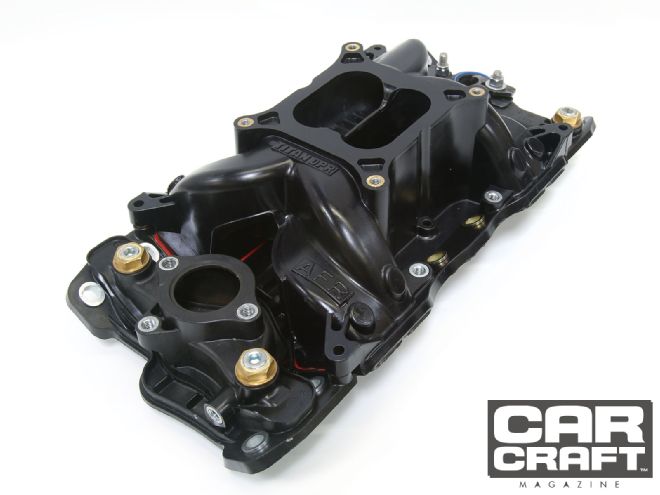 If peak torque and peak horsepower are your only goals, then look no further than the AFR composite manifold. Yes, it’s expensive, but it simply bested every other manifold.
If peak torque and peak horsepower are your only goals, then look no further than the AFR composite manifold. Yes, it’s expensive, but it simply bested every other manifold.
Peak Torque and Horsepower
Ranking Peak TQ Ranking Peak HP 1st AFR Titon 510 1st AFR Titon 484 2nd Edelbrock 7501 508 2nd Edelbrock 7501 474 3rd Edelbrock EPS 2701 506 3rd Jegs Champion 471 4th Edelbrock RPM 7101 504 4th Edelbrock RPM 7101 470 4th Weiand Warrior 8501 504 5th Pro. Prod 52021 469 4th Edelbrock 2601 504 5th Summit 226014 469 7th Summit 226010 503 7th Weiand 8150 467 8th Summit 226014 502 8th Weiand 8501 466 8th Weiand Warrior 8150 502 9th Edelbrock 7104 465 8th Weiand 8120 502 9th TFS Street Burner 465 11th TFS StreetBurner 501 11th Summit 226010 464 11th Edelbrock 7104 501 11th Dart SHP 464 11th Dart SHP 501 13th Weiand 8125 463 11th Weiand 8125 501 14th Edelbrock 2701 461 15th Chevy ZZ4 500 15th Weiand 8120 459 15th Jegs Champion 500 15th Summit 226012 459 17th Pro. Prod. Typhoon 499 17th Edelbrock 2601 458 18th Summit 226012 498 17th Pro. Prod. 52013 458 19th Prof. Prod. 52013 497 19th Pro. Prod. 52026 457 20th Prof. Prod. 52026 496 19th Chevy Iron 457 21st Edelbrock 2101 494 21st Edelbrock 2101 456 21st Chevy Iron 494 22nd Chevy ZZ4 451 23rd Pro. Prod. Cyclone 487 23rd Pro. Prod. 52001 436
Average Torque and Average Torque per Dollar
Here's where we lay it on the line. For street engines, it's not peak horsepower that makes your engine feel powerful. Street-smart engine builders emphasize torque, and while peak torque is a good indicator, we think the best judge of a dual-plane intake is average torque. This generates a single number created by averaging all the torque numbers within the test range of 2,500 and 6,200 rpm. We weren't surprised when the AFR Titon composite manifold handily won this contest. What was surprising was the tried-and-true Edelbrock Performer RPM Air Gap was within 2.4 lb-ft of the AFR at less than half the cost. It's also important to note that this evaluation really splits hairs because nearly all these manifolds produce excellent power. Let's take the Weiand 8125 Street Warrior. It made 500 lb-ft of peak torque yet is listed 15th in average torque. But when we plugged its torque curve into our Quarter, Pro dragstrip simulation, this intake is only off 0.15-second and 1 mph compared with the fourth-rated Edelbrock 7101. So you can see that most of these manifolds really do a decent job. Drop out the top and bottom two manifolds, and the total spread between 3rd and 20th is 2 percent—or 9.2 lb-ft of average torque.
For the typical car crafter, average torque per dollar is probably most important of all the ratings in this shootout. Unless your name is Bill Gates, cost and power are equally important. To come up with this evaluation, we divided the manifold's average torque by its price; the larger the number, the more power it delivers for each dollar spent. From the moment we began pricing manifolds, the Jegs Champion appeared to be a front-runner. At $99.99, all this intake had to do was make decent torque and horsepower to win this category. But, as you've seen, this intake ranked Third in peak horsepower and was capable of 500 lb-ft of torque. Trim $30 off its next closest price rivals, and the conclusion is simple: If we were to mash up all the evaluations into one overall winner, you could make a great case for the Jegs Champion intake. Note that the AFR number is a fraction, which means its price was a larger number than its average torque.
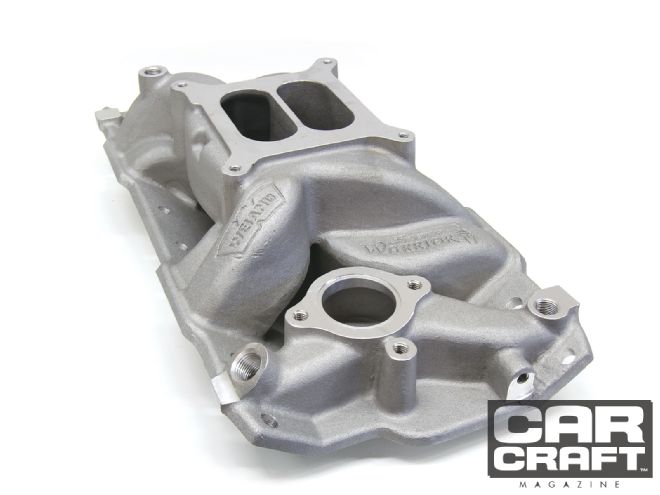 The Weiand Speed Warrior 8501 also separates the runners from the manifold floor. It placed a respectable Fourth in average torque and sixth in average torque per dollar, making it an excellent choice.
The Weiand Speed Warrior 8501 also separates the runners from the manifold floor. It placed a respectable Fourth in average torque and sixth in average torque per dollar, making it an excellent choice.
Average Torque and Average Torque per Dollar
Ranking Avg. TQ Ranking Avg. TQ/$ 1st AFR Titon 473.6 1st Jegs Champion 4.64 2nd Edelbrock 7501 471.2 2nd Summit 226014 3.49 3rd Edelbrock 7101 468.3 3rd Summit 226012 3.49 4th Weiand 8501 466.3 4th Weiand 8120 3.43 5th Edelbrock 2701 466.2 5th Edelbrock 2701 3.31 6th Summit 226010 465.6 6th Weiand 8150 3.18 7th Edelbrock 7104 465.3 7th Pro. Prod. 52001 3.12 7th Pro. Prod. 52021 465.3 8th Weiand 8125 3.05 9th TFS StreetBurner 465.2 9th Edelbrock 2101 2.90 10th Summit 226014 464.9 10th Pro. Prod. 52021 2.85 10th Weiand 8150 464.9 11th Edelbrock 7101 2.67 12th Edelbrock 2601 464.7 12th Pro Prod. 52013 2.59 13th Jegs Champion 464.5 13th Summit 226010 2.54 14th Dart SHP 463.7 14th Edelbrock 7104 2.32 15th Weiand 8125 463.5 15th Pro. Prod. 52026 2.29 16th Weiand 8120 462.8 16th Weiand 8501 2.14 17th Summit 226012 461.0 17th TFS StreetBurner 2.06 17th Pro. Prod. 52013 461.0 18th Edelbrock 2601 2.05 19th Pro. Prod. 52026 459.5 19th Edelbrock 7501 2.00 20th Edelbrock 2101 459.1 20th Dart SHP 2.00 21st Chevy Iron 459.0 21st Chevy ZZ4 1.89 22nd Chevy ZZ4 454.4 22nd Chevy Iron 1.76 23rd Pro. Prod. 52001 449.3 23rd AFR Titon 0.82
In-Car Power
What will all this power do in a car? We simulated the 7101 Edelbrock Performer RPM's power curve in a 3,450-pound Chevelle with 3.55:1 gears, a 2004R automatic, 3,000-rpm stall-speed converter, 26-inch-tall Mickey Thompson ET Street tires, and shifting at 6,400 rpm. The Quarter, Pro simulation reported that the Chevelle could run 11.50s at 117 mph with a 1.55-second 60-foot time. That's impressive for a 470hp dual-plane–equipped small-block. Keep in mind that strong average torque is what makes this combination so quick. If you recall, our single-plane intake test—with the same 406ci engine with a bigger cam—the motor made as much as 559 hp, but in the same simulated car with the same equipment, the greater horsepower only pushed the Chevelle to 11.30s at 120 mph. With more gear (like a 4.10:1, for example), the car would probably run 11-teens in the higher-horsepower configuration.
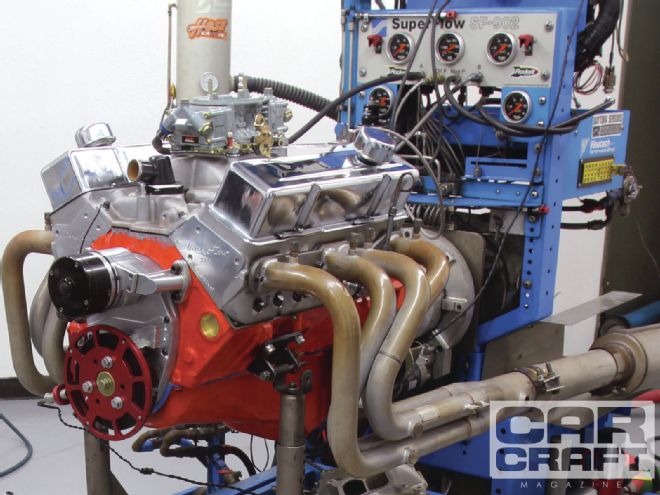 Through it all, our Rodney 406 braved more than 150 dyno pulls, and we’re not finished yet. It might just find its way into our Orange Peel Chevelle.
Through it all, our Rodney 406 braved more than 150 dyno pulls, and we’re not finished yet. It might just find its way into our Orange Peel Chevelle.
Cam Specs
Crane Roller: PN 118571 Duration at 0.050 (Degrees) Valve Lift W/ 1.5:1 (w/ 1.6:1 rockers) Lobe-Separation Angle (degrees) Intake 232 0.525 (0.560)* 112 Exhaust 240 0.543 (0.579)*
*This is gross lift. We set the lash at 0.020 inch, which must be subtracted from the gross-lift number to produce a net lift equaling 0.540/0.559.
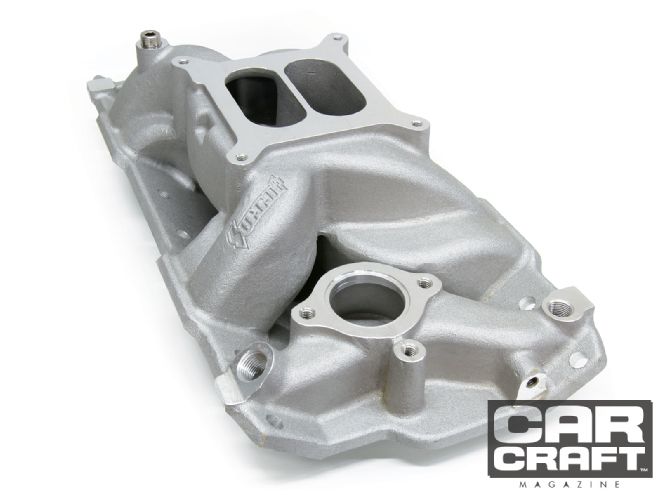 As with our single-plane test, taller manifolds generally make more power—although not always, as the results will show. The Performer RPM Air Gap separates the intake runners from the hot oil bouncing off the bottom of the manifold to reduce inlet-air temperatures. When choosing a manifold, keep in mind that it has to fit under the hood.
As with our single-plane test, taller manifolds generally make more power—although not always, as the results will show. The Performer RPM Air Gap separates the intake runners from the hot oil bouncing off the bottom of the manifold to reduce inlet-air temperatures. When choosing a manifold, keep in mind that it has to fit under the hood.
Test Parts List
Description PN Source Price TFS 215cc heads 32400007 Summit Racing $1,449.95 Crane roller cam 118571 Summit Racing 426.00 Crane roller lifters 11552-16 Summit Racing 428.80 Crane roller rockers 11755-16 Summit Racing 395.20 Crane pushrods 95642-16 Summit Racing 156.80 Crane thrust button 99164-1 Summit Racing 14.00 Fel-Pro head gasket 1143 Summit Racing 88.95 (2) Fel-Pro int. gasket 1206 Summit Racing 16.95 MSD crank trigger 8615 Summit Racing 255.95 MSD distributor 85551 Summit Racing 235.95 MSD plug wires 31229 Summit Racing 84.95 Autolite spark plugs AR3933 (8) Summit Racing 28.00 ARP head bolts 134-3701 Summit Racing 84.28 ARP intake bolts 434-2001 Summit Racing 33.70 Permatex Ultra Gr. 82194 Local Auto Parts 7.49 Carb adapter plate 2732 Summit Racing 6.95 3⁄8-inch pipe plugs (4) G1482 Summit Racing 5.95 1⁄2-inch pipe plugs (4) G1483 Summit Racing 5.95
And the Winner Is…
We will leave the final selection entirely up to you. If your budget screams for help, the Jegs Champion intake is the wallet-friendly choice. If power is your only goal, the AFR Titon is clearly the best, hands down. If power and price demand equal attention, either the Edelbrock Performer EPS (2701) Air Gap or the 8150 Weiand Speed Warrior or the Summit Stage 2 will certainly deliver. Frankly, any of the manifolds ranked in the top 15 of all our evaluations are solid choices that won't leave you with buyer's remorse. We hope we've removed some of the guesswork from your next manifold purchase.